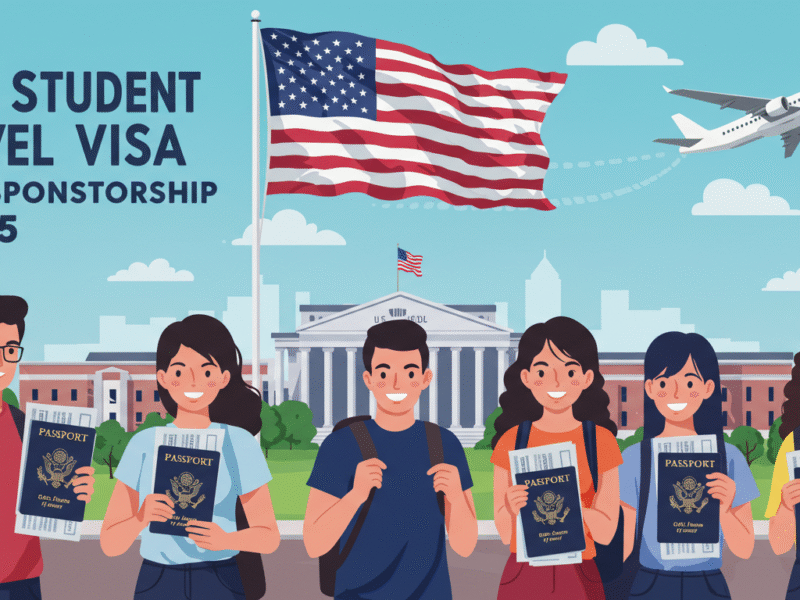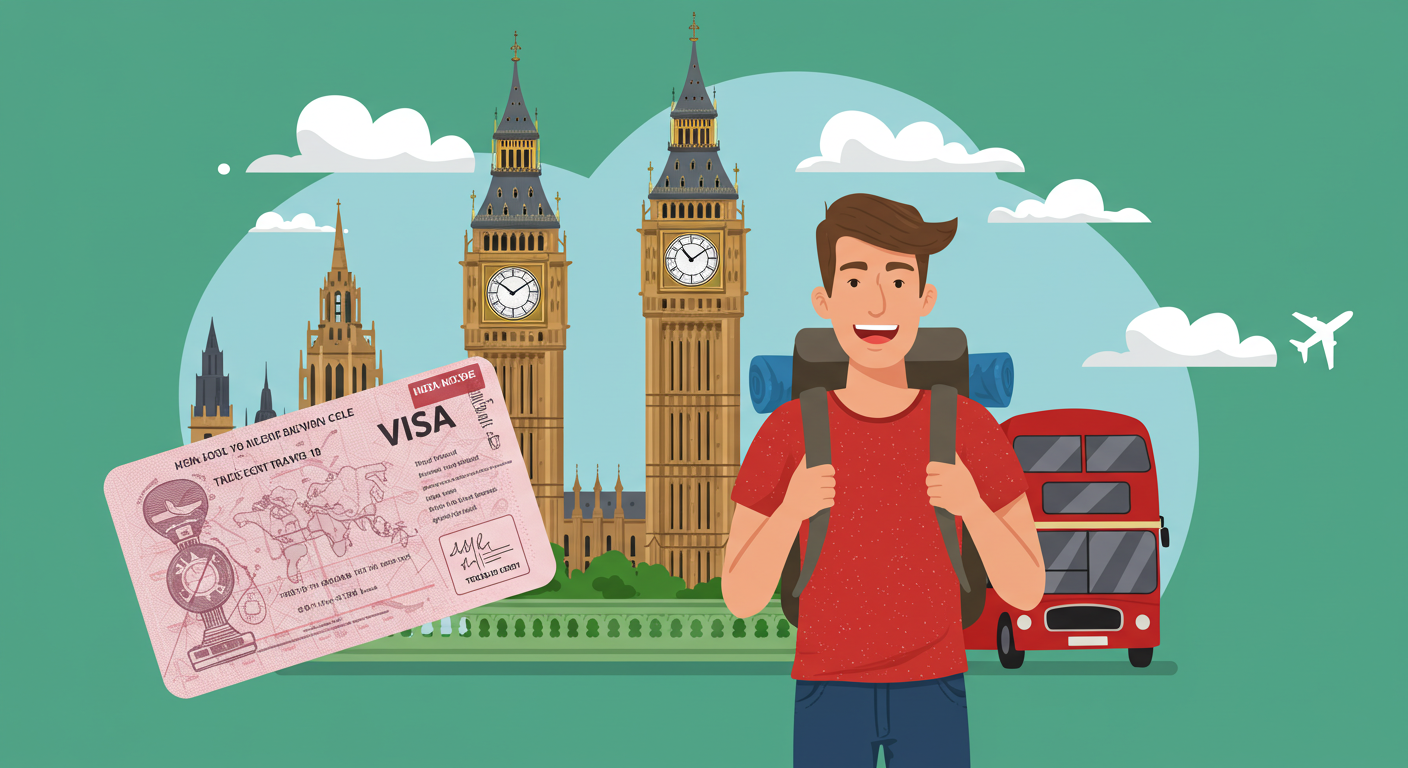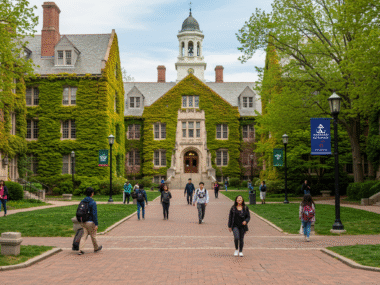Dreaming of strolling through bustling American campuses, soaking up world-class education, and building a future full of possibilities? Getting a USA student visa with sponsorship in 2025 might seem like climbing a mountain, but with the right steps, it’s totally doable – and I’m here to guide you through it like a friend who’s been there.
Why Study in the USA?
Let’s face it, studying in the USA is a game-changer for thousands of international students every year. Whether you’re eyeing a degree in engineering at MIT or business at NYU, the F-1 student visa is your golden ticket. But what about sponsorship? It’s not as complicated as it sounds – it basically means having someone or something backing you financially to prove you won’t be a burden on the US system. In 2025, the process remains straightforward, but staying updated on requirements is key to avoiding hiccups. I’ll walk you through everything from eligibility to interview tips, using simple steps and real-talk advice to make your USA student visa application smooth sailing.
Understanding the Basics of USA Student Visas
What is a USA Student Visa?
Before jumping into the how-to, let’s break down what a USA student visa really is. It’s a non-immigrant visa, meaning it’s temporary and tied to your studies. You can’t use it to live permanently in the US, but it does allow some work opportunities like on-campus jobs or optional practical training (OPT) after graduation.
Types of Student Visas
First off, understand that the USA student travel visa isn’t just any permit – it’s specifically designed for folks like you who want to study full-time. The main types are the F-1 visa for academic programs and the M-1 for vocational or non-academic training. If you’re planning to dive into university courses, F-1 is probably what you’ll need. Sponsorship here refers to financial support, not job-related like in work visas. It could come from your parents, a relative, a scholarship, or even your own savings. The US government wants to know you can cover tuition, living costs, and extras without working illegally.
Importance of Sponsorship
Why is sponsorship so important for your USA student visa in 2025? Well, consular officers at the embassy are all about ensuring you’re a genuine student who plans to return home after studies. Showing strong financial backing proves you’re serious and self-sufficient. Without it, your application could get denied faster than you can say “Statue of Liberty.” But don’t worry – millions get approved each year by getting this right.
Key Requirements for 2025
For 2025, the rules haven’t seen massive overhauls, but processing times might vary due to global events, so apply early. The US Department of State handles visas, while Homeland Security oversees the Student and Exchange Visitor Program (SEVP). Your school must be SEVP-certified – think big names like Harvard or smaller community colleges. If it’s not on the list, forget it; your I-20 form (that’s your eligibility certificate) won’t fly.
Financial Sponsorship Details
Now, about that sponsorship. In visa lingo, it’s proof of financial support. You need to show you have enough money for at least the first year of studies, plus living expenses. For a typical undergrad program, that could mean $50,000 to $80,000 or more, depending on the school and location. Living in New York? Expect higher costs than in a quieter state like Iowa. Sponsors can be family members who sign an affidavit promising to cover your bills. Scholarships count too – many universities offer them to international talents.
If you’re self-sponsoring, bank statements showing liquid assets are crucial. No one wants to see frozen accounts or loans that aren’t disbursed yet. In 2025, with inflation biting, embassies are stricter on this, so overestimate your needs to be safe.
Eligibility Criteria for USA Student Visa with Sponsorship 2025
Okay, let’s get real – not everyone qualifies. To snag that F-1 visa, you must tick these boxes:
- Acceptance to a SEVP-Approved School: You can’t apply without an offer letter. Apply to universities first, get admitted, and they’ll send your Form I-20. This form is like your visa application’s backbone.
- Full-Time Enrollment: Part-time won’t cut it. You need to be in a degree, diploma, or certificate program.
- English Proficiency: Unless your program’s in another language (rare), show TOEFL or IELTS scores. Some schools waive this if you’ve studied in English before.
- Financial Stability: Here’s where sponsorship shines. Prove you (or your sponsor) can foot the bill without relying on US jobs. Bank statements, sponsor letters, and affidavits are must-haves.
- Intent to Return Home: Ties to your country – family, property, job offers – show you’re not planning to overstay.
- Health and Character: No serious illnesses or criminal records that flag you as a risk.
For M-1 visas, it’s similar but for vocational stuff like pilot training or culinary arts. In 2025, expect more scrutiny on online programs; pure remote learning doesn’t qualify for student visas anymore post-COVID adjustments.
If you’re under 18, parental consent and guardianship in the US might be needed. And remember, your passport must be valid for six months beyond your stay.
Step-by-Step Guide: How to Apply for USA Student Visa 2025
Applying feels overwhelming, but break it into bites. Here’s your roadmap:
Step 1: Get Accepted and Receive Form I-20
Start by researching schools. Use sites like College Board or EducationUSA for options. Apply, pay deposits if needed, and once accepted, your school issues the I-20. This lists your program, costs, and funding sources. Sign it and keep it safe.
Step 2: Pay the SEVIS Fee
Before anything else, fork out $350 for the SEVIS I-901 fee online at fmjfee.com. It’s non-refundable, even if denied. Print the receipt – you’ll need it.
Step 3: Fill Out DS-160 Form
This online application is your visa request. Head to ceac.state.gov, answer honestly about your background, studies, and finances. Upload a photo (2×2 inches, white background). It takes time, so save drafts. Print the confirmation with barcode.
Step 4: Pay the Visa Application Fee
$185, non-refundable. Pay at designated banks or online, depending on your country. Get the receipt.
Step 5: Schedule Your Visa Interview
Use the US embassy site in your country to book. Wait times vary – in India or China, it could be months, so plan ahead for 2025 intakes. Interviews are mandatory for most ages 14-79.
Step 6: Gather Documents
Pack a folder with:
- Passport
- DS-160 confirmation
- I-20
- SEVIS receipt
- Visa fee receipt
- Photo (if not uploaded)
- Academic transcripts, test scores
- Financial docs: Bank statements (last 3-6 months), sponsor affidavit (Form I-134 if needed), scholarship letters
- Proof of ties: Property deeds, family photos, return tickets
For sponsorship, your sponsor’s income proof, tax returns, and a letter stating their relationship and commitment are gold.
Step 7: Attend the Interview
Dress smart, arrive early. Officers ask about your studies, finances, and plans. Be confident, concise. Sample questions: “Why this school?” “How will you pay?” “What after graduation?”
If approved, your passport gets stamped. Processing might take days.
Step 8: Enter the US
Visas can be issued 365 days before start date, but entry only 30 days prior. At the airport, show docs; CBP decides final entry.
In 2025, digital tools like the CBP One app might speed things, but always check for updates.
All About Sponsorship for Your USA Student Visa
Sponsorship is the financial lifeline of your application. It’s not about a company hiring you – that’s for H-1B. Here, it’s proving funds.
Who Can Sponsor?
- Parents or guardians: Most common.
- Relatives: Uncles, aunts, as long as they show ability.
- Self: If you have savings or assets.
- Organizations: Scholarships, grants from schools or NGOs.
What Docs Does a Sponsor Need?
- Affidavit of Support (I-134): Free form where sponsor promises aid.
- Bank statements: Showing enough balance.
- Employment letter: Proving income.
- Tax returns: Last few years.
- Relationship proof: Birth certificates.
For 2025, aim for funds covering 1-2 years. If costs are $60,000/year, show at least that plus buffers. Liquid assets like savings are preferred over property.
If multiple sponsors, each submits separate affidavits. Scholarships reduce the burden – many US schools offer merit-based aid up to full tuition.
Common pitfall: Fake sponsors. Embassies spot them; honesty wins.
Preparing for the USA Student Visa Interview in 2025
The interview is make-or-break. It’s short – 2-5 minutes – but prep like it’s an exam.
Tips for Success
- Practice answers: Know your program inside out. Why USA? Why this major?
- Be honest: Lies get caught.
- Show confidence: Eye contact, smile, clear speech.
- Dress professionally: No jeans or tees.
- Bring extras: Even if not asked, have backups.
Expected Questions
- Study plans: “What’s your course about?”
- Finances: “Who’s sponsoring? How much?”
- Future: “Will you return home?”
In 2025, with AI tools, practice via mock interviews online.
Common Mistakes to Avoid
- Vague answers: Don’t say “I like USA” – specify opportunities.
- Poor docs: Missing one? Denied.
- Weak ties: No home connections? Red flag.
- Over-talking: Keep it brief.
- Saying you’ll work off-campus illegally: Big no.
From real stories, one student got denied for not explaining a gap year properly. Learn from that – explain everything.
Documents Checklist for USA Student Visa Application
Let’s list ’em out to avoid stress:
- Valid passport
- DS-160 barcode page
- I-20 signed
- SEVIS fee receipt
- Visa fee receipt
- Recent photo
- Acceptance letter
- Test scores (SAT, GRE, etc.)
- Financial proof: Sponsor letter, banks, affidavits
- Ties evidence: Job letter, family docs
Organize in a clear folder. Copies too.
For sponsorship-heavy apps, include sponsor’s passport copy and visa if they’ve visited US.
Financial Requirements in Detail for 2025
How much bank balance? It varies. Estimate via school costs on I-20. Tuition $20,000-50,000, living $10,000-20,000, health insurance $1,000-3,000.
For Indian students, show 6-12 months’ funds. In 2025, with dollar fluctuations, have 10-20% extra.
Loans count if approved. Prodigy Finance or MPOWER offer student loans without cosigners – great for sponsorship gaps.
What If Your Visa Gets Denied?
Don’t panic – many reapply successfully. Common reasons: Weak finances, intent doubts. Get a denial letter, fix issues, reapply. Pay fees again, though.
Appeal? Rare, but new evidence helps.
Life After Getting Your USA Student Visa
Congrats! Now, maintain status: Full-time classes, no unauthorized work. OPT allows post-study work – up to 12 months, 36 for STEM.
Renewing and Traveling
Renew? If extending studies, get new I-20, apply for extension.
Travel? Re-enter with valid visa, but check rules.
Tips for International Students in 2025
- Start early: Applications open months ahead.
- Use EducationUSA centers for free advice.
- Health insurance: Mandatory, get school plans.
- Culture shock: Join clubs, make friends.
- Budget: Track expenses with apps.
Stories abound – a friend from Nigeria sponsored by an uncle aced it by showing strong home business ties.
FAQs on USA Student Visa with Sponsorship 2025
Can I work on F-1?
On-campus yes, up to 20 hours/week. Off-campus after year with approval.
Can my spouse join?
F-2 visa, but can’t work.
Can I change schools?
Possible, transfer SEVIS.
Are there COVID impacts?
Less now, but hybrid okay if in-person dominant.
Conclusion
Wrapping up, getting a USA student visa with sponsorship in 2025 is about preparation and persistence. You’ve got the dream – now execute the plan. Stay positive, and soon you’ll be living that American student life.
For official details, check the US Department of State Student Visa page or the USCIS Students and Exchange Visitors section.











